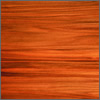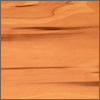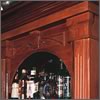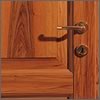|
|
||||
|
|
American gum (Liquidamber styraciflua)Other names: Redgum, sapgum, sweetgum
Click to enlarge DistributionThe gums are an important part of the Eastern hardwood forests, and are found throughout the South Eastern USA. General descriptionThe sapwood of American gum tends to be wide and is white to light pink, while the heartwood is reddish brown, often with darker streaks. The wood has irregular grain, usually interlocked, which produces an attractive grain figure. It has a fine uniform texture. Working propertiesThe wood is easy to work, with both hand and machine tools. It nails, screws and glues well, takes stain easily and can be sanded and polished to an excellent finish. It dries rapidly with a strong tendency to warp and twist. It has a large shrinkage, and is liable to movement in performance.
Physical propertiesAmerican gum is moderately hard, stiff and heavy and has a low steam bending classification. Specific Gravity: 0.52 (12% M.C.) DurabilityRated as non-resistant to heartwood decay and liable to insect attack. The heartwood is moderately resistant to preservative treatment but the sapwood is permeable. AvailabilityUSA: Readily available, often separated for colour and sold as
sapgum (sapwood) and redgum (heartwood). Main usesCabinet making, furniture parts, doors, internal joinery, strips and mouldings, turning and rail ties. Good substitute for walnut when stained.
|
|
||||||||||||||||||||||||||||||||||||||||||||||||||||||||||||||||||||||||||||




